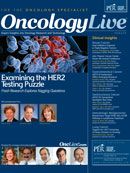Five Questions for Jill M. Siegfried, PhD
Jill M. Siegfried, PhD, is an investigator into the role of growth factors and hormones in the development and growth of lung cancer.
Jill M. Siegfried, PhD
Professor and Vice Chair, Pharmacology, University of Pittsburgh School of Medicine, Co-Director, Lung and Esophageal Cancer Program, University of Pittsburgh Cancer Institute, Pittsburgh, PA
Jill M. Siegfried, PhD, has been examining the role of growth factors and hormones in the development and growth of lung cancer, including the hepatocyte growth factor (HGF) and its receptor MET. These growth factors are being investigated as possible therapeutic targets and diagnostic or prognostic indicators for lung cancer.
1
What role does MET receptor signaling play in normal cells?
MET is critical for embryonic development and is expressed in all epithelial cells and endothelial cells, as well as in many inflammatory cells and cells of the immune system. After birth, the expression of MET declines and in the adult appears to be important in response to wounding or stress, when the ligand for MET, HGF, is released.
MET is important in wound healing and in cellular responses to hypoxia (reduced oxygen supply). HGF was first discovered to be released after partial surgical resection of the liver, but is now known to be released by many organs following wounding or stress.
2
How important is MET signaling in the development of cancer?
The MET pathway is active in many tumor types, such as liver cancer, gastric cancer, breast cancer, and lung cancer. MET is often overexpressed by tumors and, in some cases, can be activated by amplification or mutation. The ligand HGF is also often overexpressed in either the tumor stroma or in the tumor cells themselves. Increased HGF protein and MET protein have both been found to be negative prognostic indicators in several types of cancer, including breast cancer and lung cancer.
3
What MET receptor-targeted anticancer therapies are currently available or in development?
Currently, there are small-molecule tyrosine kinase inhibitors that target the MET receptor and bind to the ATP binding pocket of MET, preventing the kinase action. There are also neutralizing antibodies to the MET protein and to the ligand, HGF.
4
What has been the key discovery relating to MET receptor signaling in cancer in recent years?
Although MET is critical for cell movement and invasion, it also has proliferative effects and is angiogenic, so it affects many aspects of cancer signaling. Although the HGF-MET axis was first discovered in the liver, it appears to be important in most epithelial tumors. Since inflammatory cells express MET, it appears to also be important in tumor-related inflammation.
MET signals to many of the same signal transduction molecules as the epidermal growth factor receptor (EGFR), and can either replace or amplify EGFR signaling. In some cases, MET activity is increased in lung tumors that become resistant to EGFR inhibitors. Studies have also shown increased antitumor effect of combined EGFR-MET inhibition.
5
What is the future of research with regard to MET receptor signaling in helping our understanding of cancer or developing targeted treatments?
Although only a small percentage of tumors show MET amplification or mutation, increased expression of MET appears to be sufficient to render tumors sensitive to MET inhibition. Biomarker research is continuing to determine which patients will benefit the most from MET inhibitors and how to combine them with other targeted therapies to produce the most efficacious antitumor drug cocktails.




